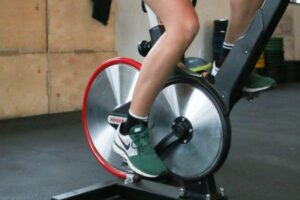
A perfect cardio routine for a healthy body
Everyone knows that working out is the best way to live a healthy lifestyle. The word cardio essentially comes from cardiovascular.
That means if you want a healthy heart, you need to increase your heart rate by doing cardio exercises. A cardio routine * decreases overall body fat, which in turn lowers hip and waist circumferences—two vital indicators of health.
It enhances the heart’s biological fitness and its capacity to pump blood enriched with oxygen to the muscles, enabling them to generate movement. (1)
Why do you need a perfect cardio routine?
Numerous elements of health, such as heart health, metabolism, mood, mental health, and sleep, are enhanced by cardio exercise.
Actually, as the heart pumps blood that carries oxygen, the lungs get more efficient at taking in oxygen, and the muscles are better prepared to use more oxygen, all of these processes grow more efficient with each beat.
However, the rise in respiration and pulse rate shouldn’t be so great that it compels you to take a break and relax. If you feel a strong need to stop and rest during a cardiac exercise, such as speed walking, cycling, swimming, running, or speed climbing, or if you have unusual pain or concerning symptoms, you should stop right away and get medical help.(2)
Which is the most common cardio routine?
You can easily create your perfect cardio routine by using a combination of the exercises below. (3)
Biking:
Biking works your legs, glutes, and hips in addition to being a great cardio workout. You can use a stationary bike at home or anywhere your bike can travel to complete the exercise. (4)
Burpees:
Burpees are a full-body workout that efficiently increases heart rate. Begin in a standing position, then lower yourself to a squat with your hands flat on the floor.(5)
Brisk walking:
Walking quickly works your legs and glutes, which are the greatest muscular groups in your body. It takes a sufficient pace (about three miles per hour) to be considered moderate exercise when walking.(6)
Circuit training:
The idea behind circuit training is to incorporate both aerobic and strength training into a single session. See your neighborhood gym’s personal trainer about creating one of these regimens. (7)
Climbing:
You can practice rock climbing in a gym or outdoors with the right safety equipment. Even climbing devices exist that function similarly to a treadmill.(8)
Elliptical:
A common piece of exercise equipment, an elliptical trainer requires you to move your legs back and forth as you’re skiing or skating. Elliptical machines are a low-impact form of exercise, and many people use them to read a book or watch TV.
High-intensity interval training (HIIT): This kind of training alternates quick bursts of activity with rest intervals. They are done in 30-second bursts; for instance, 20 seconds of intense exercise and 10 seconds of recovery are followed by a repeat of the cycle. (10)
Jumping jacks:
Place your hands at your sides and stand with your feet together to execute a jumping jack. Leap up, extending your arms until they come to rest above your head, and split your legs shoulder-width apart.
To bring your feet back together and your arms back down to your sides, jump once more. That brings an end to one leaping jack. Click here to read more about jumping jacks. (11)
Jumping rope:
All you need is the rope to perform this exercise. Revolve the rope above your head in an arc, either forward or backward; any way works. Hold one end of the rope in each hand.
When the rope sweeps near the ground, jump over it and then do it again. The rope will circle beneath you and over your head. You can attempt honing your technique by practicing jumping rope when the rope is moving in one direction, and then try doing it while the rope is flowing in the opposite direction. (12)
Lunges:
You can do forward or backward lunges to strengthen your glutes while increasing your heart rate. Put your hands on your hips and stand with your feet hip-width apart to perform a backward lunge.
Step backward with your right leg, keeping your shoulders and hips straight, until your right knee just barely touches the ground and both of your knees bend to a 90-degree angle. Step backward with your left leg to repeat the action, then return to your starting standing posture.
Push-ups:
A standard push-up is lifting oneself off the ground into a plank position with extended arms and then lowering oneself back down. Your arms, shoulders, core (abdomen) *, and other muscles are used during push-ups. Here’s how to perform push-ups correctly.*
Rowing machine:
Although you can have a personal home model, rowing machines are also found at many gyms. Since rowing doesn’t involve any jumping or other high-impact actions, it’s a great workout if you’re searching for something low-impact.
How does a cardio routine benefit our body?
A cardio routine can help improve your organs and other things in your body. As you get older, cardiovascular activity can help shield your brain.(13)
Regardless of age, physical activity has been shown in a study to potentially lower the incidence of dementia. Other advantages of the cardio routine could be:
Reducing the risk of stroke and improving blood flow.
Increasing mental capacity and recall
Guarding your brain from Alzheimer’s disease development
Take action against osteoporosis to lower your risk of hip fractures.
Control your arthritis pain and preserve your range of motion.
more blood flow to all of your cells, including the skin cells on your face. This enhances your complexion and lessens aging symptoms.
Reduce stress, as this helps ward off long-term skin disorders like eczema.
help enhance blood sugar control. Being physically active lowers the risk of type 2 diabetes, lessens the strain on this important organ, and helps regulate blood sugar.
regulates the microorganisms in your stomach. Help maintain a broad and abundant population of beneficial bacteria in your gut.
How long should you do a cardio routine?
If you are just starting out, 15 minutes of cardiovascular activity might help you become more stamina efficient.
Nonetheless, the majority of research indicates that in order to ensure a rise in aerobic capacity within 8 to 12 weeks, a cardiovascular routine needs to be done for at least 30 minutes, three times a week.
Depending on their level of fitness, athletes who use high-intensity continuous training to raise their lactate threshold should work out for 25 to 50 minutes.*
Low- or high-intensity intervals lasting at least 60 to 90 seconds should be incorporated into interval training to increase aerobic power, with one to two minutes of recovery time in between each interval.
Collaborate with an experienced fitness specialist to determine the quantity and duration of your training and recovery periods.
How hard should I push myself during the cardio routine?
Your age, your fitness goals, and your current level of fitness will all affect how hard you work out. You need to generally push your body to operate at a level of intensity that is marginally higher than your average level of effort. In fact, trainers usually advise doing 60–70% of your cardio workout, which is equivalent to working at a heart rate between 65 and 140 bpm.
It’s also important to remember that there are two types of pushing yourself: time and intensity. Do not combine the two if you want to prevent getting hurt. For instance, you might run a shorter distance more slowly or a longer one more quickly and vigorously.
Although pushing oneself takes effort, the rewards will be great. In fact, occasionally challenging oneself can result in gains in endurance, mental toughness, and cardiovascular fitness.
Why should you include warm-up and cool-down to your cardio routine?
A warm-up helps your body transition smoothly from a low to a high metabolic state, reduces the risk of injury, and improves the feel of your activity.
For at least five to ten minutes, perform the exercise you’ll be doing for aerobic fitness at a considerably reduced intensity. Exercise intensity should be gradually increased until you reach your target training range. You can incorporate some stretches to increase your flexibility into your warm-up.
Stretch the muscles you know are tight or that you will utilize during the exercise once you’ve warmed up a little. A cool-down is a method of gradually lowering your activity’s intensity.
This aids in restoring normal circulation to the blood that has been transferred to the working muscles. Once your practice is over, stroll for five to ten minutes, or gradually slow down if you’re jogging. Alternatively, in the final five to ten minutes of your workout, decrease the resistance on your bike or the speed at which you ride.
Stretching after a workout is a wonderful way to increase general flexibility since it raises blood flow and muscle warmth. During this period, strengthening activities can also be performed.(13)
A cardio routine is more than a routine. Cardio is a fantastic type of exercise that has several health advantages, such as regulated blood sugar, elevated mood, and enhanced cognitive function. You need to always remember that without a healthy routine, your body will lose many advantages that it could gain from having a healthy routine.
It’s amazing when you get older; your body and face become younger, and even your body’s performance becomes healthy and fresh. Work on your body when you are young, so your body can become strong when you get older. Choose a cardio routine for a perfect, healthy body. *


